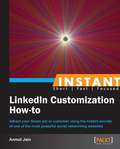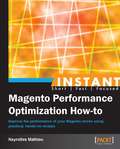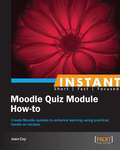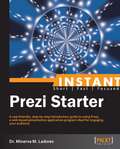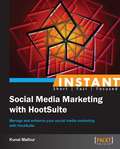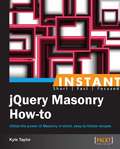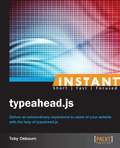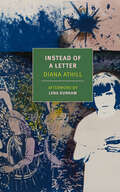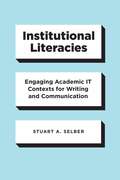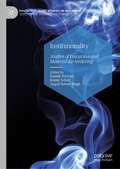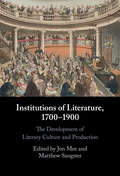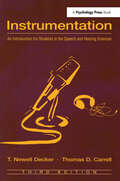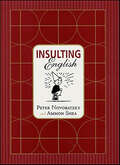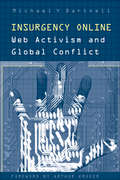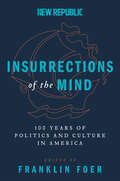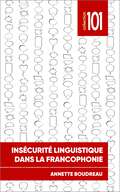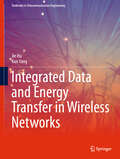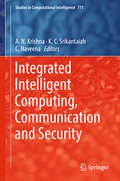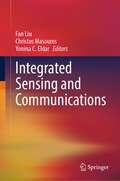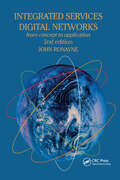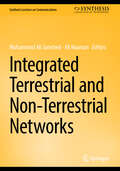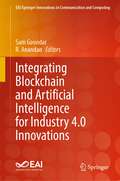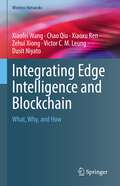- Table View
- List View
Instant LinkedIn Customization How-to
by Anmol JainStep-by step application of the features of LinkedIn provides a good grounding in creating effective résumés and optimizing your search. If you're looking for a job, genuinely interested in expanding your lifelong professional network, or simply want to learn about the tips and tricks of LinkedIn, then this is the right book for you.
Instant Magento Performance Optimization How-to
by Nayrolles MathieuFilled with practical, step-by-step instructions and clear explanations for the most important and useful tasks. Get the job done and learn as you go. A how-To book with practical recipes accompanied with rich screenshots for easy comprehension.This a Packt Instant How-to, and provides a quick and easy way to improve your Magento performance with step-by-step instructions for important tasks.This book is written for Magento administrators who are familiar with the backend console but new to anything beyond this, and wish to optimize their store for increasing performance.
Instant Moodle Quiz Module How-to
by Joan CoyStep-by step application of the features of Moodle Quiz provides a good grounding in creating effective assessment FOR and OF learning. If you are doing any kind of instruction using Moodle as your Learning Management System, this book is for you! Strong assessment is one of the keys to effective instruction and successful learners. Readers are expected to have a basic working knowledge of Moodle and access to a course they are instructing.
Instant Prezi Starter
by Minerva M. LadoresGet to grips with a new technology, understand what it is and what it can do for you, and then get to work with the most important features and tasks. A starter guide to learning how to create presentations with Prezi.Instant Prezi Starter takes you through the first steps of learning how to use this amazing web-based tool! If you are tired of your same old presentation tools and are looking to wow your audience, then this book is for you! If you surf the Internet, you're all set. If you have created a website, wiki, or blog, then you're in even better shape! Enjoy!
Instant Social Media Marketing with HootSuite
by Kunal MathurFilled with practical, step-by-step instructions and clear explanations for the most important and useful tasks. A step-by-step, short and fast-paced tutorial, packed with powerful recipes that will teach you how to enhance your social networks with HootSuite.If you are a marketer who is new to social media marketing and are looking to manage and track multiple social media profiles such as LinkedIn, Twitter, and Facebook, then this book is ideal for you. Familiarity with social media networks and tools are expected.
Instant jQuery Masonry How-to
by Kyle TaylorFilled with practical, step-by-step instructions and clear explanations for the most important and useful tasks. Get the job done and learn as you go. A concise guide that delivers immediate results with practical recipes on customizing your projects.If you have a basic understanding of jQuery, HTML, and CSS3, this book is for you. We will go over what Masonry is, how it works, and the best practices on how to implement it in your projects.
Instant typeahead.js
by Toby OsbournFilled with practical, step-by-step instructions and clear explanations for the most important and useful tasks. Instant Typeahead.js is a concise guide with 14 recipes which deals with everything you need to know to become proficient in using this tool and teaches you how to integrate it with other popular projects such as WordPress, Bootstrap, and Ruby on Rails.Instant Typeahead.js is for any web developer who would like to learn more about Typeahead.js in terms of what it can offer and the best ways to achieve common tasks. This book assumes no prior knowledge, but an understanding of JavaScript fundamentals would be useful.
Instead of a Letter
by Diana AthillWhen Diana Athill, nearly forty-three and far from a household name, sat down to write Instead of a Letter, the first in her series of trailblazing memoirs, she was looking for an answer to the question &“What have I lived for?&” In this searching book, she recalls her child-hood on her grandparents&’ magnificent estate, the teenage romance that was certain to lead to marriage, her university days coinciding with the Second World War, and the sudden dissolution of her engagement, a loss that became the defining experience of the next twenty years of her life. Athill is as forthright in confessing her faults as she is in celebrating her triumphs. &“From this table, with this white tea-cup, full ashtray, and small glass half full of rum beside me,&” she writes, &“I see my story, ordinary enough though it has all been and sad though much of it was, as a success story.&”
Institutional Literacies: Engaging Academic IT Contexts for Writing and Communication
by Stuart A. SelberInformation technologies have become an integral part of writing and communication courses, shaping the ways students and teachers think about and do their work. But, too often, teachers and other educational stakeholders take a passive or simply reactive role in institutional approaches to technologies, and this means they are missing out on the chance to make positive changes in their departments and on campus. Institutional Literacies argues that writing and communication teachers and program directors should collaborate more closely and engage more deeply with IT staff as technology projects are planned, implemented, and expanded. Teachers need to both analyze how their institutions approach information technologies and intervene in productive ways as active university citizens with relevant expertise. To help them do so, the book offers a three-part heuristic, reflecting the reality that academic IT units are complex and multilayered, with historical, spatial, and textual dimensions. It discusses six ways teachers can intervene in the academic IT work of their own institutions: maintaining awareness, using systems and services, mediating for audiences, participating as user advocates, working as designers, and partnering as researchers. With these strategies in hand, educators can be proactive in helping institutional IT approaches align with the professional values and practices of writing and communication programs.
Institutionality: Studies of Discursive and Material (Re-)ordering (Postdisciplinary Studies in Discourse)
by Yannik Porsché Ronny Scholz Jaspal Naveel SinghThis edited book brings together humanities and social sciences scholars from the various disciplines at the nexus of discourse studies and ethnography to reflect on questions of institutional practices and their political concerns. Institutional order plays an important role in structuring power relations in society. Yet, contrary to common understandings of structure, institutional orders are far from fixed or stable. They constantly change, and they are resisted and reimagined by social actors. The 20 studies collected in this edited volume develop the notion of institutionality as an overarching perspective to explore how institutional actors and institutional practices order and reorder power in societies across the globe. Thereby the chapters pay special attention to the fluidity, volatility, fragility, and ambiguity of order, and consequently to its claims to authority. Employing a broad range of discourse analytic and ethnographic methodologies, the studies show how institutions are discursively and materially constructed, defined, represented and how they are made relevant and become powerful – or how they are resisted, transformed or lose significance – in interaction. Readers will obtain nuanced insights into ways in which differently positioned social actors engage in struggles about how institutions can be imagined and enacted across several domains, such as workplace interactions, architecture, mass-media representations or organisational publicity. This book will be of interest to readers in Applied Linguistics, Discourse and Society, Critical Discourse Analysis, Political Theory and Communication Studies.
Institutions of Literature, 1700–1900
by Jon Mee Matthew SangsterThis collection provides students and researchers with a new and lively understanding of the role of institutions in the production, reception, and meaning of literature in the period 1700–1900. The period saw a fundamental transition from a patronage system to a marketplace in which institutions played an important mediating role between writers and readers, a shift with consequences that continue to resonate today. Often producers themselves, institutions processed and claimed authority over a variety of cultural domains that never simply tessellated into any unified system. The collection's primary concerns are British and imperial environments, with a comparative German case study, but it offers encouragement for its approaches to be taken up in a variety of other cultural contexts. From the Post Office to museums, from bricks and mortar to less tangible institutions like authorship and genre, this collection opens up a new field for literary studies.
Instrumentation: An Introduction for Students in the Speech and Hearing Sciences
by T. Newell Decker Thomas D. CarrellWhile keeping the scope and essential thrust of the original book unchanged, this third edition has been updated to reflect the latest technology. For instance, important revisions have been made to a few chapters, while one chapter has been eliminated and replaced with a newer chapter dealing with recent developments in digital and consumer electronics that are relevant to laboratory instrumentation. The authors hope the readers of this text will be more confident with instrumentation and more willing to experiment with it, as well as be able to appreciate the possible ways that electronic instrumentation can be used in their work. The book was written with the undergraduate in speech and hearing sciences uppermost in mind. Instead of detailed information about individual pieces of instrumentation, a more basic and broad descriptive approach has been used. Throughout, examples have been provided regarding how certain pieces of equipment can be used in the clinic or laboratory. One or more step-by-step exercises are included at the end of certain chapters to help students obtain hands-on experience and equipment flowcharts help reinforce the exercise. Students who complete this book will have a basic understanding of the major pieces of instrumentation in the hearing and speech clinic/laboratory.
Insulting English
by Ammon Shea Peter NovobatzkyAt last, a compendium of ingeniously insulting words for every occasion.For anyone who's been stymied by the level of sloth, bad looks and low intelligence of his fellow man (and woman), help is on the way. You can't change the tiresome creatures around you, but now you can describe them behind their backs with pleasing specificity.Yes, Insulting English is a user's guide to little-known and much-needed words that include:Gubbertush: Buck-toothed personHogminny: A depraved young womanNihilarian: Person with a meaningless jobPursy: Fat and short of breathScombroid: Resembling a mackerelTumbrel: A person who is drunk to the point of vomitingThese and many other gems from our colorful mother tongue are collected on these pages. Now every gink, knipperdollin, and grizely dunderwhelp can be called by his rightful name.
Insurgency Online
by Michael Y. DartnellIn Insurgency Online, Michael Dartnell focuses on a new form of conflict made possible by global communications. The Internet, Dartnell argues, is affecting extensive changes to the way politics are carried out, by inserting a range of non-state actors onto the global political stage. He demonstrates that Web activism raises issues about the organization of societies and the distribution of power and contends that the development of online activism has far-reaching social and political implications, with parallels to the influence of the invention of the printing press, the telegraph, and the radio.Dartnell concentrates on Web activists who use the Net as a media tool, distinguishing this use from information terrorism, which threatens or harasses through 'hacking' or electronic sabotage. Using the examples of the Revolutionary Association of the Women of Afghanistan (RAWA), which opposed the Taliban, the Peruvian Movimento Revolucionario Tupac Amaru (MRTA) and its campaign against the Fujimori government, and the Irish Republican Socialist Movement (IRSM), Dartnell evaluates the political implications and general character of Web activism among non-state actors. Insurgency Online shows that online activism is a ripe, new territory for non-governmental actors to raise awareness and develop support around the world.
Insurrections of the Mind: 100 Years of Politics and Culture in America
by Franklin FoerTo commemorate the 100th anniversary of The New Republic, an extraordinary anthology of essays culled from the archives of the acclaimed and influential magazineFounded by Herbert Croly and Walter Lippmann in 1914 to give voice to the growing progressive movement, The New Republic has charted and shaped the state of American liberalism, publishing many of the twentieth century’s most important thinkers.Insurrections of the Mind is an intellectual biography of this great American political tradition. In seventy essays, organized chronologically by decade, a stunning collection of writers explore the pivotal issues of modern America. Weighing in on the New Deal; America’s role in war; the rise and fall of communism; religion, race, and civil rights; the economy, terrorism, technology; and the women’s movement and gay rights, the essays in this outstanding volume speak to The New Republic’s breathtaking ambition and reach. Introducing each article, editor Franklin Foer provides colorful biographical sketches and amusing anecdotes from the magazine’s history. Bold and brilliant, Insurrections of the Mind is a celebration of a cultural, political, and intellectual institution that has stood the test of time.Contributors include: Virginia Woolf, Vladimir Nabokov, George Orwell, Graham Greene, Philip Roth, Pauline Kael, Michael Lewis, Zadie Smith, William Faulkner, Ralph Ellison, James Wolcott, D. H. Lawrence, John Maynard Keynes, Langston Hughes, John Updike, and Margaret Talbot.
Insécurité linguistique dans la francophonie (Collection 101)
by Annette BoudreauVous êtes-vous déjà demandé si vous parliez le français qui convient ? Avez-vous déjà eu honte de votre manière de parler ou de la manière de parler des gens de votre communauté ? Si oui, cet ouvrage vous aidera à mieux comprendre les mécanismes qui régissent ces comportements langagiers. L’insécurité linguistique, fréquente dans la francophonie, serait issue de la façon dont la langue française s’est développée, de l’idée d’une norme unique et d’une vision unitaire et uniforme du français, qui perdure et qui est à la base d’exclusions sociales. Cet ouvrage décrit le phénomène de l’insécurité linguistique, son histoire, ses manifestations, et ses retentissements. Il porte précisément sur l’insécurité linguistique dans la francophonie et puise ses exemples dans la francophonie canadienne.Cet essai propose une analyse des principales manifestations du continuum qu’est l’insécurité linguistique, de l’hypercorrection – sa forme la plus légère – à la honte et au silence. Il explore les liens entre insécurité linguistique et diglossie, soit les rapports de domination entre groupes de personnes qui parlent des langues différentes ou entre personnes qui parlent la même langue. Enfin, il examine le rôle joué par les idéologies linguistiques et sociales dans la construction identitaire, idéologies masquées qui régissent les discours et qui agissent sur les comportements langagiers.
Integrated Data and Energy Transfer in Wireless Networks (Textbooks in Telecommunication Engineering)
by Kun Yang Jie HuThis textbook offers a comprehensive guideline for integrated data and energy transfer, from theoretical fundamentals to practical implementations and applications. This book is suitable for students, engineers and scientists in electronic engineering who are interested in the integrated data and energy transfer in future wireless networks. The authors cover waveform and transceiver design in the physical layer, resource allocation and medium access control protocol, networking and deployment as well as practical implementation of the wireless integrated data and energy transfer. The authors commence from information theoretical fundamentals, physical layer design principles, medium access control, and networking techniques. The book ends with a practical prototype of integrated data and energy transfer. The book is geared towards graduate students and senior undergrads having a general background of wireless communications. The book features exercises, Q&A, and examples throughout.
Integrated Intelligent Computing, Communication and Security (Studies in Computational Intelligence #771)
by A. N. Krishna K. C. Srikantaiah C NaveenaThis book highlights the emerging field of intelligent computing and developing smart systems. It includes chapters discussing the outcome of challenging research related to distributed computing, smart machines and their security related research, and also covers next-generation communication techniques and the networking technologies that have the potential to build the future communication infrastructure. Bringing together computing, communications and other aspects of intelligent and smart computing, it contributes to developing a roadmap for future research on intelligent systems.
Integrated Sensing and Communications
by Yonina C. Eldar Fan Liu Christos MasourosThe coming generations of wireless network technologies will serve, not only as a means of connecting physical and digital environments, but also to set the foundation for an intelligent world in which all aspects are interconnected, sensed, and endowed with intelligence. Beyond merely providing communication capabilities, future networks will have the capacity to "see" and interpret the physical world. This development compels us to re-imagine the design of current communication infrastructures and terminals, taking into account crucial aspects such as fundamental constraints and tradeoffs, information extraction and processing technologies, issues of public security and privacy, as well as the emergence of numerous new applications. This field of research is known as Integrated Sensing and Communications (ISAC), and it has ushered in a paradigm shift towards the omnipresence of radio devices.This book provides the first comprehensive introduction to the ISAC theoretical and practical framework. Each chapter is authored by a group of world-leading experts, including over 10 IEEE Fellows. Readers can expect to gain both a broad overview and detailed technical insights into the latest ISAC innovations.
Integrated Services Digital Network: From Concept To Application
by J RonayneAn introduction to "ISDN" which brings the technology up-to-date, incorporating developments in "ATM", "SDH" and Broadband "ISDN". This book is suitable for self-learning communications professionals and applied courses in communications management and technology, and advanced undergraduates and graduates in computing and electronics.
Integrated Terrestrial and Non-Terrestrial Networks (Synthesis Lectures on Communications)
by Muhammad Ali Jamshed Ali NaumanThis book aims to address a wide range of topics in wireless/satellite communications to tackle the issues related to the integration of terrestrial networks (TN) with non-terrestrial networks (NTN). In Release 17, the third-generation partnership project (3GPP) proposed the standardization of NTN to allow 5G-based TN to support NTN. According to Release 17, the NTN will consist of satellites, with unmanned aerial vehicles (UAVs) and high-altitude platforms (HAPs) regarded as specific use cases of NTN. Similar to the Global Positioning System (GPS), signals based on NTN are unable to provide indoor coverage, as these signals are attenuated and scattered by roofs, walls, etc. Moreover, power and delay are critical factors that restrict a cellular-enabled mobile handset from achieving reliability, seamless coverage, and low latency while relying on NTN. This book has brought together multidisciplinary contributors in the field of wireless/satellite communications to identify and present technical challenges and recent results related to the design of energy-efficient, delay-tolerant, and enhanced coverage-based integrated TN and NTN. Given that challenges and future aspects are also considered, the book covers a wide variety of subject categories and would therefore benefit a larger readership in the scientific community.
Integrating Artificial Intelligence and IoT for Advanced Health Informatics: AI in the Healthcare Sector (Internet of Things)
by Carmela Comito Agostino Forestiero Ester ZumpanoThe book covers the integration of Internet of Things (IoT) and Artificial Intelligence (AI) to tackle applications in smart healthcare. The authors discuss efficient means to collect, monitor, control, optimize, model, and predict healthcare data using AI and IoT. The book presents the many advantages and improvements in the smart healthcare field, in which ubiquitous computing and traditional computational methods alone are often inadequate. AI techniques are presented that play a crucial role in dealing with large amounts of heterogeneous, multi-scale and multi-modal data coming from IoT infrastructures. The book is intended to cover how the fusion of IoT and AI allows the design of models, methodologies, algorithms, evaluation benchmarks, and tools can address challenging problems related to health informatics, healthcare, and wellbeing.
Integrating Blockchain and Artificial Intelligence for Industry 4.0 Innovations (EAI/Springer Innovations in Communication and Computing)
by Sam Goundar R. AnandanThis book discusses the convergence of artificial intelligence (AI) and Blockchain and how they can work together to help reach the goals of Industry 4.0. The authors first discuss how AI and Blockchain can help increase performance in business. The authors go on to discuss how the technologies can integrate to provide a competitive edge for businesses through improvements in big data, which has allowed firms to organize huge datasets into structured components that computers can process quickly. The authors also cover security implications and how AI and Blockchain can act as a double-edged sword against cyber-attacks. Impacts in programming, calculations, robotization, robots, and equipment are also discussed. This book caters to an extensive cross-sectional and multi-disciplinary readership. Academics, researchers and their students in topics such as artificial intelligence, cyber-physical systems, ethics, robotics, safety engineering, and safety-critical systems should find the book of value.
Integrating Edge Intelligence and Blockchain: What, Why, and How (Wireless Networks)
by Dusit Niyato Xiaofei Wang Victor C. Leung Chao Qiu Xiaoxu Ren Zehui XiongThis book examines whether the integration of edge intelligence (EI) and blockchain (BC) can open up new horizons for providing ubiquitous intelligent services. Accordingly, the authors conduct a summarization of the recent research efforts on the existing works for EI and BC, further painting a comprehensive picture of the limitation of EI and why BC could benefit EI. To examine how to integrate EI and BC, the authors discuss the BC-driven EI and tailoring BC to EI, including an overview, motivations, and integrated frameworks. Finally, some challenges and future directions are explored. The book explores the technologies associated with the integrated system between EI and BC, and further bridges the gap between immature BC and EI-amicable BC.Explores the integration of edge intelligence (EI) and blockchain (BC), including their integrated motivations, frameworks and challenges;Presents how BC-driven EI can realize computing-power management, data administration, and model optimization;Describes how to tailor BC to better support EI, including flexible consensus protocol, effective incentive mechanism, intellectuality smart contract, and scalable BC system tailoring;Presents some key research challenges and future directions for the integrated system.
Integrating IoT and AI for Indoor Air Quality Assessment (Internet of Things)
by Malka N. Halgamuge Maitreyee Dutta Gonçalo Marques Jagriti SainiThis book presents Internet of Things (IoT) solutions monitoring and assessing a variety of applications areas for indoor air quality (IAQ). This book synthesizes recent developments, presents case studies, and discusses new methods in the area of air quality monitoring, all the while addressing public health concerns. The authors discuss the issues and solutions, including IoT systems that can provide a continuous flow of data retrieved from cost-effective sensors that can be used in multiple applications.The authors present the leading IoT technologies, applications, algorithms, systems, and future scope in this multi-disciplinary domain.
